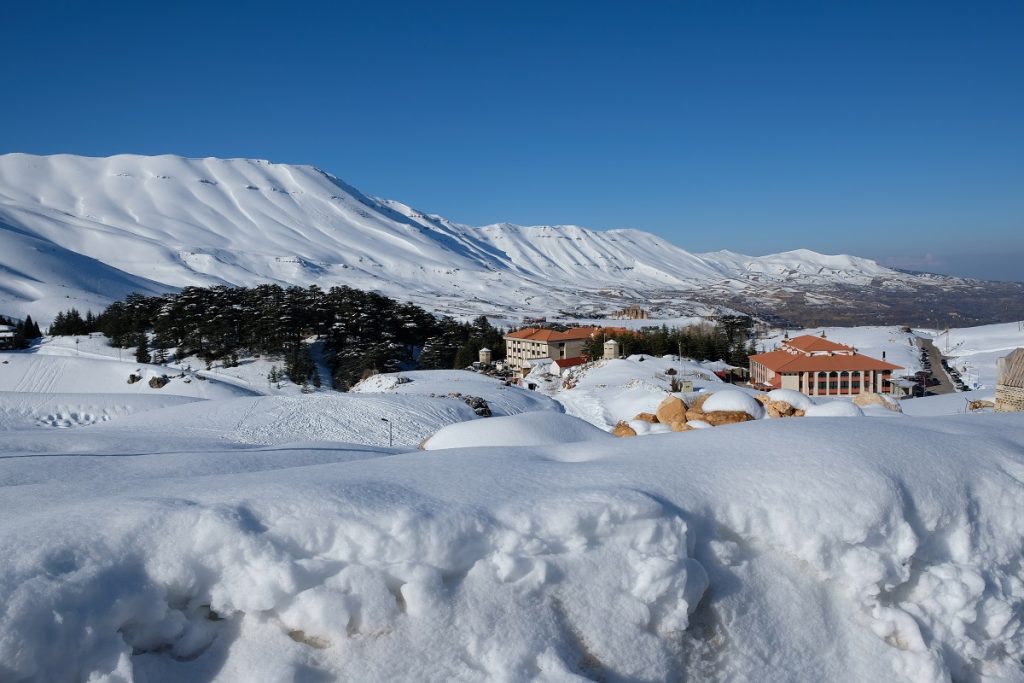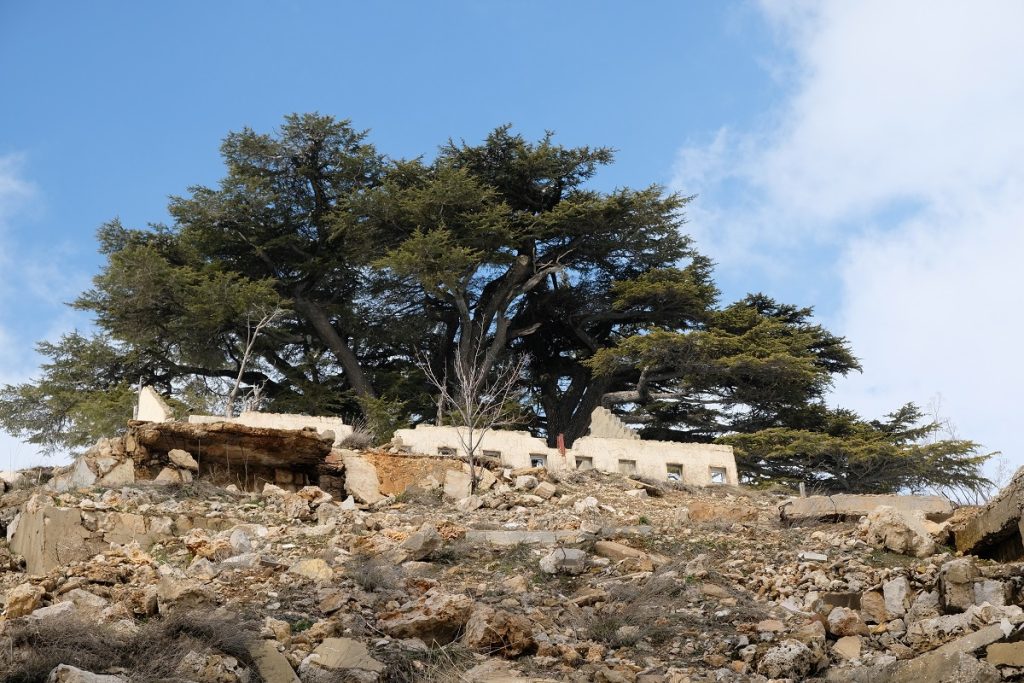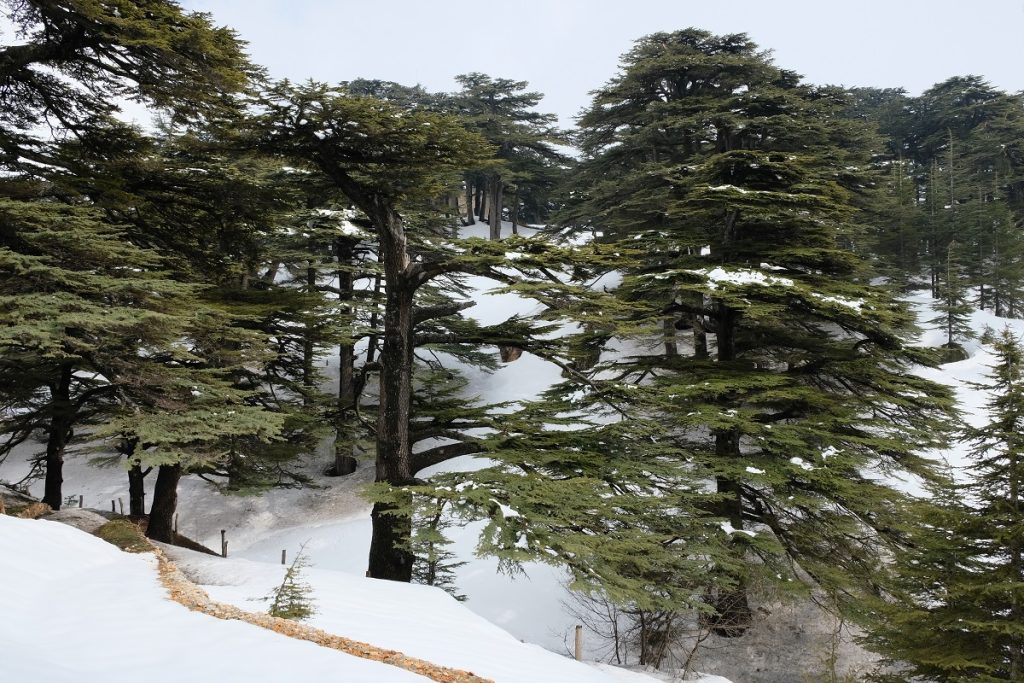On our final day in Beirut, it was drizzling, just like how the Lebanese capital was throughout most of our stay. While the city had been all I expected it to be – fascinating, chaotic, vibrant, sobering, inspirational – I couldn’t wait to continue the journey toward the alluring snow-capped peaks of the Mount Lebanon range to the northeast. Mahmoud, James’s old friend who had helped me obtain my Lebanese visa (which is notoriously hard to get for Indonesians) assured us a few days earlier, “you’ll definitely get a lot of snow in the mountains.” And there was a silver lining to the dreary, rainy weather that greeted us on the coast. “It’s unusually wet for early April,” Mahmoud added, pointing out a tell-tale blanket of white that crowned the hilly landscape visible from Beirut’s Corniche.
Due to the distance, the relatively limited time we had in Lebanon, and the fact that our next accommodation was located high up in the mountains, we decided to arrange a pick up in advance. Wafik was the one who would take us from Beirut all the way to The Cedars, or Al Arz in Arabic, home to the legendary Cedrus libani, also known as the Cedars of God. It was already 12 PM and Wafik was supposed to have arrived at our hotel, but he was nowhere to be seen. Then I got a voice message from him on WhatsApp. “Hello, this is Wafik. I will arrive in 30 minutes. Very bad traffic.” I texted him to say it was fine and we would wait for him inside the hotel lobby. I also asked him what his car was just to make sure I would immediately notice him once he arrived. “Ford, white Ford,” he replied with another voice message in a fashion that almost reminded me of 007’s most famous line.
About half an hour later he finally arrived and apologized for being late. Coming from a city with some of the worst traffic jams in the world, I totally understood and sympathized with him for he had left the mountains quite early in the morning. We soon departed, but not without having to endure a little more of Beirut’s congestion. “Ya Rabb,” he murmured, expressing his frustration of the traffic conditions and the constant rain while waiting for the light to turn green at an intersection. In Indonesia, this expression – which literally means Oh, Lord – is usually said only by Muslims. But hearing an Arab Christian saying it reminded me that I was traveling in a part of the world that is home to three Abrahamic religions which share the same roots, and later on the journey I learned how similar Christian and Muslim prayers sound in Arabic, to my Indonesian ears at least.
Once we left Beirut for its northern outskirts, we then took the coastal road that snakes along the Mediterranean Sea. We passed Jounieh, Byblos, and before venturing further on to Tripoli – Lebanon’s second largest city – we took a right turn and kept climbing toward the mountains from there. While the weather was fair throughout the coastal drive, as we went up a thick blanket of fog gradually obscured the sea and the mountains. Then it descended upon the houses, before making the road itself barely visible. Wafik remained calm and steady at the wheel. He must have known this road like the back of his hand since he’s native to Bsharri (also spelled Bcharre), the closest town to Al Arz. It was in fact Bsharri that made me dream of visiting this part of Lebanon in the first place, for all the photos of it that I had seen years before depicted a little town with a spectacular natural setting that seemed too good to be true. However, James who is more familiar with the story of the cedars convinced me to stay in Al Arz instead for our accommodation would be just a short walk away from one of the oldest cedar groves in the entire country.




The so-called Cedars of God have been an important source of wood since antiquity for its durability. The Phoenicians used the wood to build ships that helped propel them to become a powerful nation in the Mediterranean region; the Ancient Egyptians used the timber for the mummification process of their kings and queens; the Sumerian king Gilgamesh built his city with loads of cedar wood; and in the Bible, King Solomon (known as Sulaiman in the Muslim world) constructed the Temple of Jerusalem using the same type of cedars; the Roman emperor Hadrian designated the cedar forests in the Lebanese mountains an imperial domain which helped prevent their over-exploitation; the Ottomans and the British used them to build railroads; and the modern Lebanese, understanding the trees’ significance for millennia and the country’s importance as the main source of the cedars, immortalized them on the nation’s flag.
As we went higher, Wafik kept a steady speed while maneuvering the hairpin bends of the mountain road. We passed one town after another with an information board indicating our altitude before entering each locality. “Welcome to Bsharri,” Wafik proudly told us as we approached his hometown, its supposedly beautiful vistas completely covered in thick fog, although I could still see its main cathedral on top of a hill. Al Arz shouldn’t have been that far now, yet no snow was in sight although I tried to remain optimistic. After going through a tunnel and passing several other buildings in Bsharri, we finally emerged into a majestic landscape completely blanketed in the white powder. It was still very cloudy, but looking at that much snow so close to me for the very first time, I was overcome with a wave of excitement. So much so that I desperately wanted to get out of the car right away and touch the thick pile of cotton-like frozen water, something I’d only seen on TV and the internet. Half an hour after we left Bsharri, we arrived at our accommodation for the next two nights, a cozy mountain resort owned by a very hospitable old man and manned by equally friendly staff members who were extremely helpful whenever we needed them.
We had a simple yet very hearty late lunch at the resort, enjoyed in a cozy lounge warmed by logs that crackled and burned inside a rustic fireplace. It was very quiet and peaceful there, a stark contrast to the cacophony of the Lebanese capital where we had been for the previous three nights. From the lounge I could see a chairlift climbing up a mountain peak not too far from the resort. Rafael, the owner, told us that in high season guests from other Arab countries as well as Europe would flock to this part of Lebanon to ski in this Middle Eastern winter wonderland.




That afternoon, we left the warmth of the resort and walked toward the cedar grove, a small group of the famous trees down the hill from where we were. Along the way, I couldn’t resist touching the fresh snow; as someone who has lived in the tropics my entire life, I was mesmerized by the sheer novelty of it all. The snow was piled up so high it blocked the entrance way to a house, and it cloaked the roofs of some houses and the mountain slopes save the tall trees where we were heading. Later on the trip we were told that the cedars in Al Arz are considered the oldest in Lebanon, dating back to 3,000 – 4,000 years ago. Unfortunately, today the population of Cedrus libani is dwindling thanks to over-exploitation in the past and its seedlings’ susceptibility to fungal attacks, which are on the increase thanks to global warming. Thick snow, like what we were experiencing, actually helps to keep the fungi at bay.
As we were approaching the grove, rows of souvenir stalls began to appear on both sides of the small road. A huge cedar tree stood up ahead, providing shade for the surrounding stalls. Walking underneath it was magical as I realized that this very tree has been there for millennia, silently watching the changes in its surroundings. “Hello, where are you from?” a middle-aged woman greeted us and smiled as we walked past her shop. She was the friendliest among other shop owners that we saw, so we thought we would drop by her stall after taking some photos of the cedars which still looked impressive even on a cloudy afternoon. Their trunks bore lines and cracks formed throughout the many years of their existence in the world, and the snow on the ground was like a clean canvas on which the cedars and pine trees were planted, becoming a source of admiration for generations of Homo sapiens.
We returned to that stall and learned that the owner’s name is Nana. While engraving James’s brother’s name on a piece of wood, she explained to us that she made all the souvenirs from fallen branches of the cedars. At the next stall, which apparently was still hers, her oldest son pulled out a jar of honey for us to try. Its woody fragrance and fruity flavor were very delightful, and we decided to buy a jar to bring back to Indonesia.
Before the day got darker, we walked back to our accommodation up on the hill, past roads that had been cleared of the snow – beside the asphalt, the snowdrifts piled up more than two meters high. As we were getting near the resort, the sun was slowly setting behind us. We turned and watched how the Mediterranean Sea glimmered on the horizon. Three days earlier we had seen Mount Lebanon’s snow-capped peaks from Beirut’s Corniche on the eastern end of the Mediterranean, and now we were standing at a vantage point that showed us the complete reverse. What a most pleasant way to end our first day in Al Arz! But little did we know that we would be extremely lucky the following day as we went down to Bsharri and explored a portion of the majestic Qadisha Valley in the most perfect weather.


